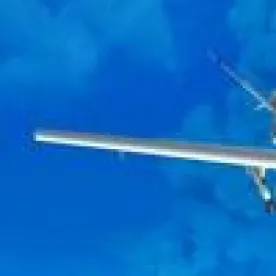On Sunday, February 15, the Federal Aviation Administration and White House addressed the growing use of unmanned aircraft systems (UAS) by the private sector and government. The FAA issued a Notice of Proposed Rulemaking (NPRM) that would allow limited commercial use of UAS (also known as drones) that weigh less than 55 pounds. The White House released a memorandum that imposes privacy restrictions on government use of UAS, and directs the National Telecommunications and Information Administration to work with the private sector to develop voluntary best practices for the commercial use of UAS. This client alert provides an overview of key provisions of both the NPRM and the White House memorandum.
FAA Notice of Proposed Rulemaking
Currently, the commercial use of UAS is prohibited, unless the operator qualifies for a special exemption. The FAA’s 195-page NPRM would allow limited commercial use of small UAS, subject to a number of operational and certification requirements.
An FAA Regulatory Evaluation identified four potential markets for small UAS:
Aerial photography,
Precision agriculture,
Search and rescue/law enforcement, and
Bridge inspection.
The Regulatory Evaluation, which appears to have been posted online accidentally and has since been removed, found that the NPRM would not only enable new technologies for these markets and other new marketplace opportunities, but using a small UAS in place of a manned aircraft would save costs and improve safety.
It is important to note that the NPRM is merely an initial proposal. Comments on the FAA’s proposal are due 60 days after the NPRM is published in the Federal Register. The rules would not become final until after a review and comment period expected to last about two years. In the meantime, commercial UAS operations remain prohibited absent an exemption from the FAA. The agency said it will continue to process exemption applications while the proposed rules are finalized.
Operating Requirements
The FAA states that its proposed rules would allow the use of UAS in certain commercial operations, including crop monitoring, power line or pipeline inspection, antenna inspection, rescue operations, bridge inspections, aerial photography, and wildlife observation. To mitigate the risks posed by the operation of unmanned aircraft, the FAA proposes a number of limitations on the operation of small UAS (those weighing less than 55 pounds). The limitations include:
Operations can only be conducted during daylight (sunrise to sunset);
The UAS’s maximum permitted airspeed is 100 mph;
The UAS may not fly above 500 feet above ground level;
The UAS must remain within the visual line of sight of the operator or a visual observer;
The UAS must remain close enough to the operator for the operator to see the aircraft without devices such as binoculars;
The UAS may not operate over any person not directly involved in the operation, unless the person is below a covered structure, such as a house or building;
A person may only operate one UAS at a time.
In drafting the rules, the FAA focused on two primary safety concerns: ensuring that UAS would be able to “see and avoid” other aircraft, and minimizing the risk posed to persons, property or other aircraft by a UAS that loses communication with its operator. The FAA also wanted to ensure that UAS operation would not pose a threat to national security.
The proposed rules limit commercial operation in two key ways: They require the small UAS to remain within the visual line of sight of the operator, and they prohibit operation over individuals not involved in the drone operation. The line of sight rule would limit, at this time, drone use by delivery companies and others that would require drones to travel significant distances.
The proposed rules permit the use of a “visual observer,” who would watch the UAS and remain in communication with the operator, but the FAA emphasized that the operator would still be required to have the “capability for visual line of sight,” so the UAS would not be able to travel too far away from the operator. The FAA also specifically ruled out the use of a “daisy-chain” formation of visual observers because it would pose an increased risk to the public. Visual observers would not be required to pass tests or certifications.
Importantly, for media organizations and others that may use UAS in crowded areas, the proposed rules prohibit the operation of a small UAS “over a person who is not directly participating in the operation of that small unmanned aircraft.” The prohibition does not apply to persons inside or underneath a covered structure, because they would presumably be protected if the drone lost communication and fell out of the sky. The FAA suggests that for drone use in a residential area, for instance, the operator could ask everyone in the area of operation to remain inside their homes during the operation. (But, the FAA acknowledges, the operator could not require individuals to remain inside their homes during the drone operation. If people refused to comply, the operator would not be permitted to operate his or her UAS.)
While this proposed rule could be particularly limiting for news organizations and others, the FAA has proposed a potential solution: the creation of a “micro UAS” category for drones weighing 4.4 pounds and less. Drones in this category would be allowed to fly over any person, up to 400 feet above ground level. The operator would self-certify but not be required to pass the knowledge test required for operators of small UAS (those weighing between 4.5 pounds and 55 pounds). Because these micro UAS would pose a much lesser safety risk if they crashed into a person, the FAA would allow them to be flown over people not involved in the operation. However, to further minimize the safety risk, the FAA is considering requiring that these micro UAS be made of “frangible materials that break, distort, or yield on impact.”
The FAA is continuing to develop rules for operations that do not fall within the small UAS or micro UAS parameters, or that would need to require beyond an operator’s visual line of sight. Because these operations would pose greater risk, they will be the subject of a future, separate rulemaking. For now, however, the FAA will accept comments on its proposed small UAS and micro UAS rules.
Certification Requirements
The FAA also is proposing to require UAS operators to obtain a certification. The FAA had considered proposing a requirement that UAS operators obtain a standard commercial pilot certificate. But the agency decided against such a stringent proposal, reasoning that “given the lower level of public risk posed by small UAS operations, the FAA decided that imposing such requirements would be unduly burdensome to small UAS operators.” The FAA also opted against requiring UAS operators to demonstrate that they have requisite flight proficiency and aeronautical experience.
Instead, the FAA would require drone operators to obtain a specialized commercial UAS operator certificate. Among the requirements for obtaining and maintaining the certificate:
Be at least 17 years old, consistent with the FAA’s requirements for Sport Pilot, Recreational Pilot, and Private Pilot airman certificates.
Proficiency in reading, speaking, and writing English.
Pass an initial aeronautical knowledge exam that would “test whether the applicant understands how to determine the classification of specific airspace and what the requirements are for operating in that airspace.” The exam also would include questions about the regulations applicable to drones, whether the applicant understands how to clear an obstacle during flight, weather, calculating a drone’s weight and balance, emergency response, aeronautical decision-making, communications, and physiological effects of drugs and alcohol.
Pass a recurrent knowledge exam, every 24 months, that tests their knowledge of UAS regulations, airspace classification and operating requirements, obstacle clearance requirements, flight restrictions, weather, airport operations, emergency procedures, crew resource management, and aeronautical decision-making/judgment.
Undergo vetting by the Transportation Security Administration.
Make the UAS available to the FAA for inspection and testing.
Within 10 days, report accidents that result in personal injury or property damage.
The FAA typically requires commercial aircraft to receive an airworthiness certificate, which typically takes three to five years to obtain. The FAA’s proposal does not require drone operators to obtain airworthiness certificates, recognizing that “it is not practically feasible for many small UAS manufacturers to go through the certification process required of manned aircraft.” Instead, the FAA proposes a requirement that drone operators ensure that the aircraft is in safe operating condition before each flight. The FAA also proposes a requirement that all drones display their aircraft registration number.
White House Privacy Memorandum
The White House memorandum primarily focuses on privacy issues that arise with the government’s use of UAS. Federal agencies currently use drones for a wide range of purposes, such as monitoring forest fires and protecting borders. Among the White House’s new restrictions on the federal government’s use of drones:
Federal agencies that use UAS must notify the public about where they plan to operate the UAS in the national airspace, inform the public about any changes that might affect privacy and civil liberties, and provide the public with an annual summary of the agency’s UAS operations during the previous year. Agencies are not required to provide information that could “reasonably be expected to compromise law enforcement or national security.”
Federal agencies must review their use of UAS at least every three years to ensure that the use complies with the federal Privacy Act. The agencies must ensure that they only collect information pursuant for an authorized purpose. Agencies also may not retain personally identifiable information that is collected via UAS for more than 180 days, unless the retention is necessary for an authorized mission or subject to another exception. The memorandum also restricts the dissemination of information collected via UAS.
Agencies must ensure that their policies prohibit the collection, use, retention, or dissemination of UAS information in a manner that violates the First Amendment or civil rights laws. Agencies also must “ensure that adequate procedures are in place to receive, investigate, and address, as appropriate, privacy, civil rights, and civil liberties complaints.”
Agencies must establish policies, oversight procedures, and training to prevent misuse of information collected via UAS.
State and local government agencies that receive federal grants for UAS purchases must safeguard individual privacy and civil liberties.
For commercial UAS use, the memorandum directs the NTIA, within 90 days, to begin a multi-stakeholder engagement process for voluntary best practices for privacy, accountability, and transparency issues. The NTIA has not yet provided additional information about how it will collect comments for this process.





 />i
/>i
